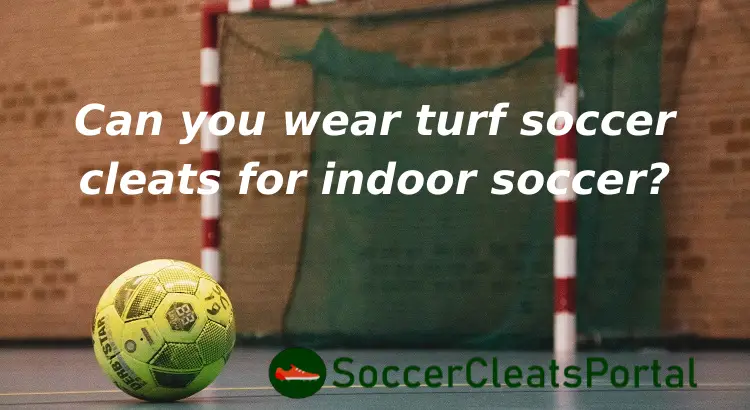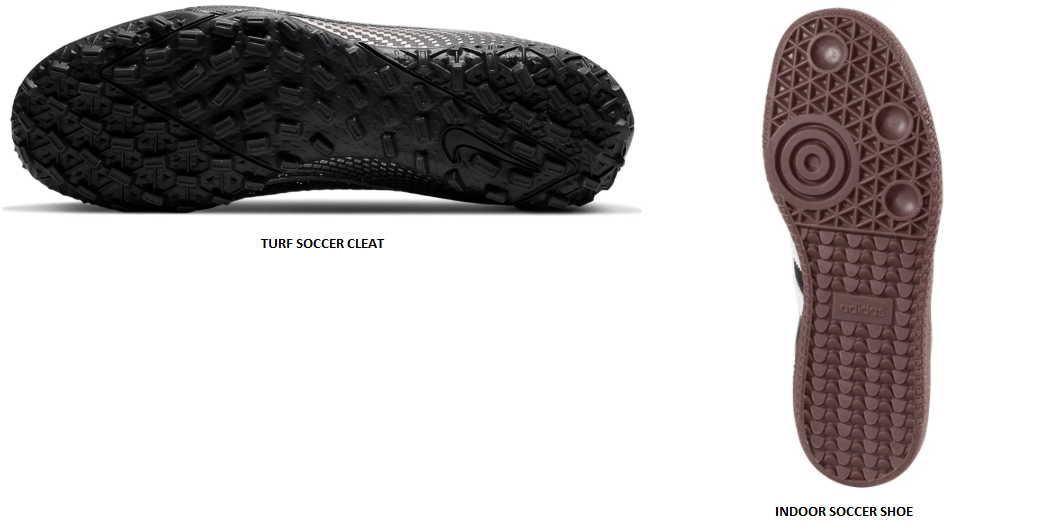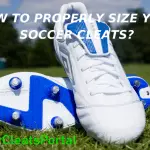Soccer enthusiasts love playing this game without caring too much about the ground on which it’s played, but there is always the issue of the correct equipment for each terrain. Soccer is most commonly known as a sport that’s played on grass. However, turf or artificial grass is often used as a replacement for grass terrain, and they require a particular type of soccer cleats. We also indoor soccer like futsal, which is played on hard wooden surfaces.
So the question is: Can you play indoor soccer with your turf soccer cleats? Yes, you can, but it is not advisable. Your turf cleats will wear out a bit faster on these terrains. Also, the risk of slippage and eventually injury is higher. Finally, there is always the possibility that the nubs of the shoes leave marks on the floor.
Let’s take a look at how turf soccer cleats compare to your average indoor shoes.
Can you wear turf soccer cleats for indoor soccer?
Turf soccer cleats are used to play on synthetic grass terrains. Turf shoes are pretty versatile, so there shouldn’t be any problems with your game on hard surfaces.
According to Futsal laws of the game that is issued from the soccer highest governing authority, the FIFA, the appropriate footwear should be ”canvas or soft leather training or gymnastic shoes with soles of rubber or a similar material.”
The same rules are also stated to the United States FUTSAL® (USFF) that has been Governing the Sport of Youth Futsal, Adult Futsal, and Professional Futsal in the United States since 1981.
So turf cleats that are made of rubber sole are not explicitly excluded as possible shoes for an indoor soccer player.
The main feature of these shoes is their sole. The rest of it is pretty similar to your average soccer boot. Turf cleats have small rubber studs on the sole, instead of larger plastic studs that are used for grass. This is done to provide the needed traction when playing on turf fields.
But what are the differences between the indoor shoes and the turf shoes that make them more suitable for indoor gym courts?
What’s the Difference Between Indoor and Turf Soccer Cleats?
The main difference between indoor soccer shoes and turf cleats is the shoe’s sole. Turf cleats have many little studs spread on the entire outsole, while these aren’t present on your average indoor soccer shoe.
On the other hand, indoor shoes have a flat rubber sole. The bottom of the shoe is made with patterns that provide you with more traction when playing on hard terrain. As a result you can make easier starts and turns in your game.
Because of the different soles, a slight difference in grip can be noticed when comparing these two types of shoes. Indoor soccer shoes will make contact with the floor with their whole surface, while turf cleats touch it only with their studs. This can have different effects in different circumstances. If you’re playing on a clean terrain, indoor soccer shoes will provide you with some increase in traction.
Another critical difference is that the shoes that you use on wooden surfaces mustn’t leave any marks. This can be a problem when playing with turf cleats. On the other hand, indoor soccer shoes are made with this in mind, so they are in the clear in this regard.
Many aspects of these shoes are very similar, which is to be expected. For example, there aren’t any noticeable weight differences when comparing them. Also, the materials used are pretty much the same.
Do You Need Special Shoes for Indoor Soccer?
Indoor soccer shoes are quite different from your average running shoe. Shoes that are specially made for indoor soccer will give you a better feeling of the ball. You will also be able to make better forward and lateral movements. The thick sole of the running shoe is filled with air and isn’t made with the same purpose in mind, so you may encounter some traction problems. You can certainly stick with your regular shoes instead of ones that are meant for soccer, but you will experience a decrease in your efficiency.
As mentioned above, indoor soccer can also be played with turf cleats. As long as there aren’t any marks left on the surfaces, you should be good to go. Some players may even prefer their turf cleats over regular indoor soccer shoes. But you have to take into account that your turf cleat will get damaged a bit faster when you aren’t playing on turf ground.
The most important aspect you need to consider is the risk of injury. Indoor soccer courts are slippery and smooth, so you need to get the maximum of contact between the shoe and the surface to avoid slide on. Only flat soccer indoor shoes offer that as with the turf cleats only a small amount of the sole will get in touch with the ground.
Can You Use Indoor Soccer Shoes on Turf or Grass?
In general, indoor soccer shoes are not a right choice for playing on turf or grass. First off, we should mention that there isn’t any rule that prohibits you form using indoor soccer shoes on a turf field. However, this may not be in your best interest, as your game will be affected.
Although it’s not as bad as regular grass, the ground on a turf terrain is still too slippery for your average flat rubber sole. Indoor soccer shoes are made for smooth, hard terrains, and the lack of any studs will be problematic when playing on turf.
Players that play with turf cleats have a considerable advantage when compared to players wearing indoor shoes on this ground. There will probably be many slips and falls, which can even lead to injuries. Also, you should note that indoor soccer shoes can easily get worn out when playing on turf.
Here you can find more information about the best soccer shoes for indoor courts.
Final thoughts
When it comes to professional soccer it is always advisable to wear shoes that are designed specifically for the surface you are going to play.
There are many adverse effects on your game as well as injury risks if you are wearing unsuitable soccer cleats.
All in all, you will be better off with turf cleats only on turf ground. Turf soccer cleats should only be used for hard courts only as a secondary option.





